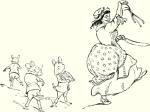A shady mousetrap (About Agatha Christie's "Three Blind mice")

Following the murder of a seemingly unsuspicious old woman, most of the action in Agatha Christie’s Three Blind Mice takes place in Monkswell Manor, a guesthouse that has just been inaugurated by a newlywed couple. The setting is a classic one, an isolated location that is made further inaccessible by a conveniently timed blizzard. Despite some unsurprising ingredients in this popular recipe for murder mysteries, the short story is on the whole quite an enjoyable read. However, there is one central problem that does not escape the scrutiny of Intercripol, and potentially changes the plausibility of Christie’s plot.
Let me start by providing some context to this humble critique of one of my all-time favourite authors. To summarise briefly, the six people in Monkswell Manor at the time of the murder are the two hosts- Giles and Molly Davis, four guests, and a policeman who makes a grand entry on his skis. The guests are an odd mix of layered personalities, which unravel as the plot unfolds. The first to appear is an “almost-architect”, Christopher Wren, an eccentric man who shows indecent and inappropriate interest in all the gory details of the murder. The next to arrive is Mrs Boyle who is described as a “large, forbidding-looking woman with a resonant voice and a masterful manner; a natural aggressiveness heightened by a war career of persistent and militant usefulness”. She gives off the impression of a permanently displeased woman who can manage to criticise everything under the sun. The third guest, the most composed and sensible-looking of the lot, is Major Metcalf, a “stolid, middle-aged man of spruce military appearance”, who gives nothing away even as we begin to discover the dark undertones of the other characters. The last guest is an unexpected arrival at midnight in the midst of the blizzard, a Mr Paravicini who is let in by the hosts in consideration of the unruly weather. This foreign and uncalled for guest gives off a very strange vibe as he creeps about the place, with his knack for entering rooms unnoticed and startling everyone in this especially frightening context of murder. To add to the disgruntled atmosphere fuelled by bad weather, isolation and a clash of opposing personalities, a telephone call from the police informs Molly of the arrival of a young policeman- Inspector Trotter, who skies his way into the scene in a rather impressive fashion. Trotter reveals that a notebook (identified as belonging to the murderer) was found near the previous crime scene and contained the addresses of both the first victim and that of Monkswell Manor, followed by the nursery rhyme “Three Blind Mice” (suggesting that there were to be three murders). Trotter claims that he has been sent by the county police to catch the murderer who is supposedly hidden amongst those in the guesthouse. What follows is a series of suspicions arising in the party, Molly suspecting her husband, Giles in turn suspecting Wren who he thinks has an on-going affair with Molly, Mrs Boyle being suspicious of everybody and so on. After a fair bit of foreshadowing, Mrs Boyle is found dead. Trotter then orchestrates a re-enactment of the activities at the time of the murder and this time it is Molly Davis who becomes his next target. But she is saved just in time by Major Metcalf who reveals himself as the real policeman as they discover that Trotter is the murderer who was posing as a cop.
The greatest flaw in the tale is the inability of the real policeman to stop a murder despite being aware of the characters’ histories as well as the suspicious presence of an imposter-cop. The murderer’s intention to kill these three women lies in his past: he was one of three children who were evacuated to Longridge Farm in 1940 under the care of Mr and Mrs Gregg. One of the children died as a result of abuse and neglect, and the couple was arrested. The first victim was in fact the same Mrs Gregg who had been released from prison after the completion of her sentence and was then killed by the murderer. At Monskwell Manor, the two next victims were Mrs Boyle, the ticketing officer who at the time was responsible for having sent the children to Longridge Farm, and Molly Davis, the sister of the children’s schoolteacher (who the children had written to pleading for help, but was ill and did not receive the note until after the death of the child; but the murderer is unaware of this detail and mistook Molly for her sister). Major Metcalf is clearly aware of these two women’s past and even mentions to Mrs Boyle that she is withholding important information from Trotter after he questions them about their connections with the Longridge Farm case, to which Molly responds saying that she does indeed remember Mrs Boyle being the ticketing officer at the time. Furthermore, Major Metcalf mentions at the end that he “had been onto him [Trotter] all along”, knowing that he was an imposter. During Metcalf’s interaction with the murderer in the climax scene, we see the boy transforming into “a piteous child”- owing to his psychiatric issues. Metcalf gently reassures him that he will not be harmed and leads him away from the scene. If he was aware of the boy’s troubles all along, why wait until he has murdered one person and attempted to shoot yet another victim?
This implausible story might work if Major Metcalf was connected in some way to the murderer and had an ulterior motive for capturing the boy, but that seems not to be the case here.